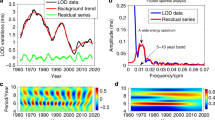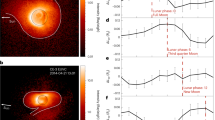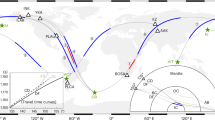Abstract
Variations in Earth's rotation (defined in terms of length of day) arise from external tidal torques, or from an exchange of angular momentum between the solid Earth and its fluid components1. On short timescales (annual or shorter) the non-tidal component is dominated by the atmosphere, with small contributions from the ocean and hydrological system. On decadal timescales, the dominant contribution is from angular momentum exchange between the solid mantle and fluid outer core. Intradecadal periods have been less clear and have been characterized by signals with a wide range of periods and varying amplitudes, including a peak at about 6 years (refs 2, 3, 4). Here, by working in the time domain rather than the frequency domain, we show a clear partition of the non-atmospheric component into only three components: a decadally varying trend, a 5.9-year period oscillation, and jumps at times contemporaneous with geomagnetic jerks. The nature of the jumps in length of day leads to a fundamental change in what class of phenomena may give rise to the jerks, and provides a strong constraint on electrical conductivity of the lower mantle, which can in turn constrain its structure and composition.
This is a preview of subscription content, access via your institution
Access options
Subscribe to this journal
Receive 51 print issues and online access
$199.00 per year
only $3.90 per issue
Buy this article
- Purchase on Springer Link
- Instant access to full article PDF
Prices may be subject to local taxes which are calculated during checkout




Similar content being viewed by others
References
Gross, R. S. in Treatise on Geophysics, Vol. 3 (ed. Herring, T. A. ) Ch. 9, 107–130 (Elsevier, 2007)
Vondrak, J. The rotation of the Earth between 1955.5 and 1976.5. Stud. Geophys. Geod. 21, 107–117 (1977)
Liao, D. C. & Greiner-Mai, H. A new DELTA LOD series in monthly intervals (1892.0–1997.0) and its comparison with other geophysical results. J. Geod. 73, 466–477 (1999)
Abarco del Rio, R., Gambis, D. & Salstein, D. A. Interannual signals in length of day and atmospheric angular momentum. Ann. Geophys. 18, 347–364 (2000)
Gorshov, V. L. Study of the interannual variations of the Earth's rotation. Sol. Syst. Res. 44, 487–497 (2010)
Gillet, N., Jault, D., Canet, E. & Fournier, A. Fast torsional waves and strong magnetic field within the earth's core. Nature 465, 74–77 (2010)
Abarco del Rio, R., Gambis, D., Salstein, D. A., Nelson, P. & Daid, A. Solar activity and earth rotation variability. J. Geodyn. 36, 423–443 (2003)
Mound, J. E. & Buffett, B. A. Detection of a gravitational oscillation in length-of-day. Earth Planet. Sci. Lett. 243, 383–389 (2006)
Mandea, M., Pais, R. H. A., Pinheiro, K., Jackson, A. & Verbanac, G. Geomagnetic jerks: rapid core field variations and core dynamics. Space Sci. Rev. 155, 147–175 (2010)
Alexandrescu, M. M., Gibert, D., Hulot, G., Le Mouël, J.-L. & Saracco, G. Worldwide wavelet analysis of geomagnetic jerks. J. Geophys. Res. 101, 21,975–21,994 (1996)
Pinheiro, K., Jackson, A. & Finlay, C. C. Measurements and uncertainties of the occurrence time of the 1969, 1978, 1991, and 1999 geomagnetic jerks. Geochem. Geophys. Geosyst. 12, Q10015 (2011)
Pinheiro, K. & Jackson, A. Can a 1-d mantle electrical conductivity model generate magnetic jerk differential time delays? Geophys. J. Int. 173, 781–792 (2008)
Holme, R. & de Viron, O. Geomagnetic jerks and a high-resolution length-of-day profile for core studies. Geophys. J. Int. 160, 435–439 (2005)
Olsen, N. & Mandea, M. Rapidly changing flows in the Earth’s core. Nature Geosci. 1, 390–394 (2008)
Gross, R. S. & Chao, B. F. The rotational and gravitational signature of the December 26, 2004 Sumatran earthquake. Surv. Geophys. 27, 615–632 (2006)
Holme, R. Magnetic ringing of the Earth. Nature 459, 652–653 (2009)
Bloxham, J. The expulsion of magnetic flux from the Earth’s core. Geophys. J. R. Astron. Soc. 87, 669–678 (1986)
Bloxham, J., Zatman, S. & Dumberry, M. The origin of geomagnetic jerks. Nature 420, 65–68 (2002)
Wardinski, I., Holme, R., Asari, S. & Mandea, M. The 2003 geomagnetic jerk and its relation to the core surface flows. Earth Planet. Sci. Lett. 267, 468–481 (2008)
Benton, E. R. & Whaler, K. A. Rapid diffusion of the poloidal geomagnetic field through the weakly conducting mantle: a perturbation solution. Geophys. J. R. Astron. Soc. 75, 77–100 (1983)
Backus, G. E. Application of mantle filter theory to the magnetic jerk of 1969. Geophys. J. R. Astron. Soc. 74, 713–746 (1983)
Holme, R. in The Core–Mantle Boundary Region (eds Gurnis, M., Wysession, M. E., Knittle, E. & Buffett, B. A. ) 139–151 (American Geophysical Union, 1998)
Buffett, B. A. Constraints on magnetic energy and mantle conductivity from the forced nutations of the Earth. J. Geophys. Res. 97, 19581–19597 (1992)
Olsen, N. Long-period (30 days – 1 year) electromagnetic sounding and the electrical conductivity of the lower mantle beneath Europe. Geophys. J. Int. 138, 179–187 (1999)
Velimsky, J. Electrical conductivity in the lower mantle: constraints from CHAMP satellite data by time-domain EM induction modelling. Phys. Earth Planet. Inter. 180, 111–117 (2010)
Ono, S., Oganov, A. R., Koyama, T. & Shimizu, H. Stability and compressibility of the high-pressure phases of Al2O3 up to 200 GPa: implications for the electrical conductivity of the base of the lower mantle. Earth Planet. Sci. Lett. 246, 326–335 (2006)
Hernland, J. W., Thomas, C. & Tackley, P. J. A doubling of the post-perovskite phase boundary and structure of the Earth’s lowermost mantle. Nature 434, 882–886 (2005)
Acknowledgements
O.d.V. was supported by Centre National d’Études Spatiales (CNES) through the TOSCA (Terre, Océan, Surfaces Continentales, Atmosphère) programme, and by the French Institut Universitaire de France. The oceanographic model used is a contribution of the Consortium for Estimating the Circulation and Climate of the Ocean (ECCO) funded by the National Oceanographic Partnership Program.
Author information
Authors and Affiliations
Contributions
R.H. performed the primary analysis and led the writing of the manuscript. O.d.V. provided the original data with corrections for atmosphere and ocean, and contributed to writing the manuscript.
Corresponding author
Ethics declarations
Competing interests
The authors declare no competing financial interests.
Supplementary information
Supplementary Figures
This file contains Supplementary Figures 1-4 and additional references. (PDF 430 kb)
Rights and permissions
About this article
Cite this article
Holme, R., de Viron, O. Characterization and implications of intradecadal variations in length of day. Nature 499, 202–204 (2013). https://doi.org/10.1038/nature12282
Received:
Accepted:
Published:
Issue Date:
DOI: https://doi.org/10.1038/nature12282
This article is cited by
-
Inner core static tilt inferred from intradecadal oscillation in the Earth’s rotation
Nature Communications (2023)
-
Ultra-short-term prediction of LOD using LSTM neural networks
Journal of Geodesy (2023)
-
Earth’s Rotation: Observations and Relation to Deep Interior
Surveys in Geophysics (2022)
-
Applications and Challenges of GRACE and GRACE Follow-On Satellite Gravimetry
Surveys in Geophysics (2022)
-
Gravity Variations and Ground Deformations Resulting from Core Dynamics
Surveys in Geophysics (2022)
Comments
By submitting a comment you agree to abide by our Terms and Community Guidelines. If you find something abusive or that does not comply with our terms or guidelines please flag it as inappropriate.



